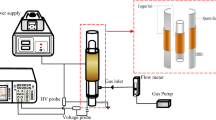Abstract
Here, we have studied the purification of water from phenol and tetracycline by oxidation with ozone and hydroxyl radicals generated in a corona electric discharge. Liquid circulation has been used to process large volumes. It has been established that tetracycline decomposes from a concentration of 11 mg/L to (1.7 ± 0.3) × 10−3 mg/L at a dose of 140 J/50 mL. Phenol decomposes more slowly, the oxidation rate decreases at low residual concentrations. The phenol concentration decreases from 13 mg/L to (27 ± 5) × 10−3 mg/L at a dose of 5 × 104 J/50 mL. The reasons for the strong decrease in the rate of phenol oxidation at low concentrations in the case of oxidation by hydroxyl radicals are analyzed.




Similar content being viewed by others
REFERENCES
S. S. Timofeeva and O. S. Gudilova, XXI Vek. Tekhnosf. Bezopasn. 6, 251 (2021).
A. K. Singh, L. Cheng, A. Hussain, and A. Maiti, Environ. Res. 26, 115678 (2023).
V. A. Terekhova, I. I. Rudneva, A. A. Poromov, et al., Voda: Khim. Ekol., Nos. 3–6, 92 (2019).
A. C. Faleye, A. A. Adegoke, K. Ramluckan, et al., J. Water Health 15, 982 (2017).
S. G. Paramonov, D. D. Zelikova, L. V. Sklyarova, and I. M. Altukhova, Formuly Farmats. 4, 76 (2022).
N. S. Antropova, O. V. Ushakova, M. A. Vodyanova, and O. N. Savostikova, Ross. Zh. Vosstan. Med., No. 4, 36 (2020).
N. Jendrzejewska and E. Karwowska, Water Sci. Technol. 77, 2320 (2018).
C. X. Chen, A. Aris, E. L. Yong, and Z. Z. Noor, Environ. Sci. Pollut. Res. 29, 4787 (2022).
P. T. Nguyen, H. T. Nguyen, U. N. P. Tran, and H. M. Bui, J. Chem. 2021, 9981738 (2021).
S. Umrantezcanun Eren Ocal and Ayse Gul, Int. J. Adv. Sci. Eng. Technol. 6, 2321 (2018).
L. Phoon, C. C. Ong, M. S. Mohamed, et al., J. Hazard. Mater. 400, 122961 (2020).
S. Adil, B. Maryam, E.-J. Kim, and N. Dulova, Environ. Res. 189, 109889 (2020).
S. Das and S. Sengupta, Water Conserv. Sci. Eng. 8, 10 (2023).
V. Abramov, A. Abramova, V. Bayazitov, et al., Processes 10, 2063 (2022). https://doi.org/10.3390/pr10102063
I. M. Piskarev, Tech. Phys. 44, 53 (1999).
I. M. Piskarev, IEEE Trans. Plasma Sci. 49, 1363 (2021).
J. R. Lakowicz, Principles of Fluorescence Spectroscopy (Plenum, New York, 1986).
S. D. Razumovskii and G. E. Zaikov, Ozone and Its Reactions with Organic Compounds (Nauka, Moscow, 1974) [in Russian].
I. M. Piskarev, High Energy Chem. 54, 205 (2020).
I. P. Ivanova, I. M. Piskarev, and S. V. Trofimova, Am. J. Phys. Chem. 2, 44 (2013).
Yu-Ran Luo, Handbook of Dissocisation Energies in Organic Compounds (CRC, Boca Raton, 2003).
Funding
This work was supported by ongoing institutional funding. No additional grants to carry out or direct this particular research were obtained.
Author information
Authors and Affiliations
Corresponding author
Ethics declarations
The author of this work declares that he has no conflicts of interest.
Additional information
Publisher’s Note.
Pleiades Publishing remains neutral with regard to jurisdictional claims in published maps and institutional affiliations.
Rights and permissions
About this article
Cite this article
Piskarev, I.M. Possibilities of Corona Electric Discharge for Deep Purification of Drinking Water from Phenol and Tetracycline. Russ. J. Phys. Chem. (2024). https://doi.org/10.1134/S0036024424030191
Received:
Revised:
Accepted:
Published:
DOI: https://doi.org/10.1134/S0036024424030191




